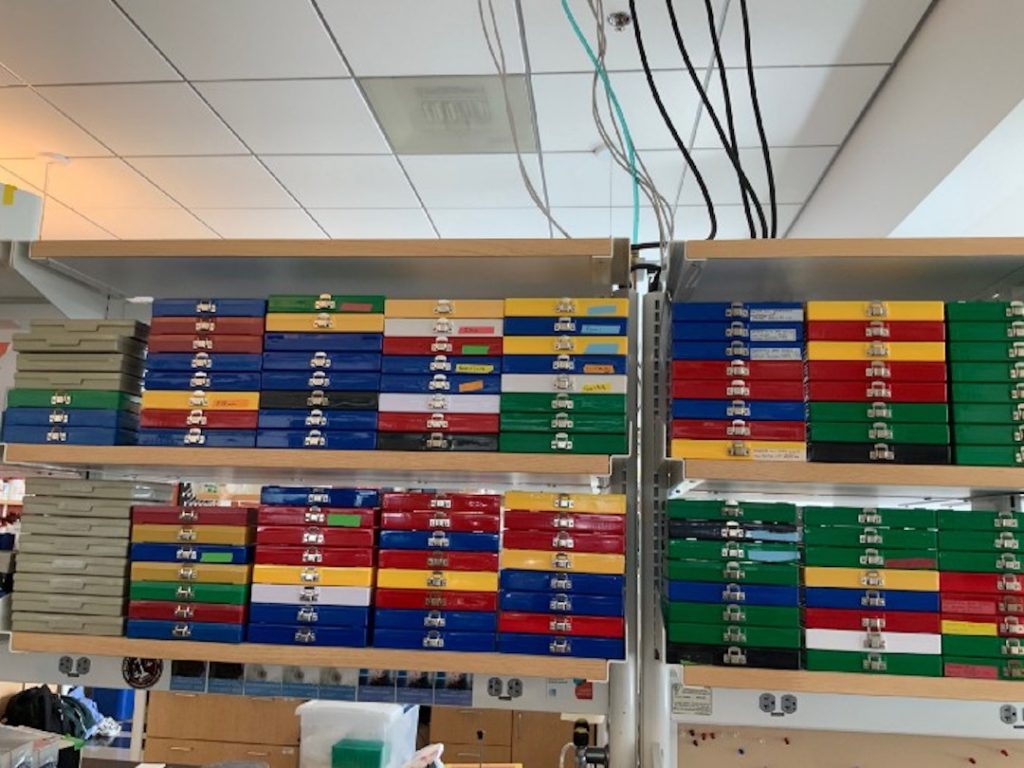Research science is at a crossroads when it comes to waste reduction. Moving toward a circular economy for research can change everything, but how do you incorporate circularity into lab design?

How to build a circular lab
Research organizations are facing a simultaneous resource waste and funding crisis. Waste is, of course, an issue at most organizations, however the Rheaply team has seen the scale of the problem facing research organizations firsthand in support of large-scale laboratory clear-outs. What’s alarming is that nobody can fully understand the scope of the problem because of limited statistics and even fewer audits. A 2015 Nature report estimates bio scientific waste is responsible for ~2% of total global plastic production, the equivalent of 67 cruise ships worth of plastic per year. It’s safe to assume that number has likely increased.
Speaking of 2%, if we were to divert just 2% of lab plastics from landfill it would be the equivalent of saving 100 million metric tons of CO2.

Why does research waste exist?
- Research time is for a time for…research, and waste minimization is perceived to be an effort and time away from the bench (in a broken system, it is).
- Space is a premium, and collection bins are hard to find. In many cases, research buildings have insufficient space for basic recycling.
- Support is required from multiple stakeholders to operationalize reuse (campus recycling, hazardous waste/EHS officers, building managers, and many, many more).
- Recycling in research is also a broken system (also everywhere else). Limited funding exists for traditional recycling, let alone recycling the hard/rigid plastics found in lab consumables, hazardous waste, and other materials. Furthermore, in many cases, the energy input involved in doing so is too high to offset the cost of recycling in the first place.
- Limited # of vendors practice extended producer responsibility and simultaneously provide take-back programs for their products.
- Time. In many cases, the exchange programs that exist within research organizations are unable operationalize reuse because of time constraints (items must be removed quickly if a lab is moving/decommissioned)
A lot is changing because of this. Facilities are consolidating and centralizing knowledge and technology. Makerspaces and core facilities exist to boost collaboration and equipment sharing. Scientists, research directors, equipment managers, sustainability and waste management professionals are becoming increasingly aware of the vendors that have zero-waste manufacturing facilities, are packaging conscientious, or take a sustainable design approach to manufacturing. And, because of the dwindling purchasing power of research grants, sharing research resources, especially among large research organizations that are frequently upgrading/moving labs, is also gaining steam.
Awareness of these issues is at an all time high, and waste has never been worse.
Several organizations remain in a planning stage, with an eye towards building a task force for waste reduction with a 2025, 2030 or 2050 net zero waste goal.
What can be done to reduce or eliminate research waste?
1. Work with lab product suppliers that design out waste.
The International Institute for Sustainable Laboratories (I2SL) Waste Diversion Group, an organization devoted to the principles of sustainable laboratories and related high-technology facilities, from design to engineering to operation, recently provided a short list of vendors that are starting to embrace the mindset of designing research materials with an eye towards environmental impact, end of life, and material recovery.
- VWR
- Kimberly Clark
- New England Biolabs
- Thermo Fisher Scientific
- Millipore-Sigma
- Starlab
- Addgene
- E&K Scientific
- Cardinal
- Triumvirate
- RightCycle
In addition, My Green Lab, a pioneer in laboratory sustainability, has created an ACT label that functions like an eco-nutrition label for lab products, providing information about the environmental impact of manufacturing, using, and disposing of a product and its packaging. Its acronym is Accountability, Consistency, and Transparency (ACT), with a goal of making it easier to choose safe, sustainable products and apply powerful methodologies to measure waste stream and recycling material flows.
2. Audit your existing internal reuse exchange program (create one now)
Because limited materials from the lab are accepted by local recyclers (and that process itself is flawed), a reuse program must be in place. Internal reuse programs (especially in academia) exist to increase the likelihood of nearby research labs to obtain products on the cheap or free. While there are some that are robust enough to handle the various centralized administrative tasks to operationalize reuse AND adhere to policies for sharing, very few homegrown reuse systems are powerful enough to do so at scale (i.e. managing assets throughout their lifecycle, capital asset management, transparency and access to sustainability metrics, support for chemical or partial sharing, etc.). This requires an improved collection infrastructure and wide-scale adoption of technology — end-to-end circularity.
3. Build circularity into reuse programs
To take this idea a step further, most reuse programs fail to create a circular network of resources/materials outside of their immediate reuse circles. In order to properly exit excess property that may remain after the initial wave of interest (to personnel in another department/functional units, charities, other universities, high schools, etc.), there needs to be a seamless way to immediately alert nearby adjacent organizations who may be interested in the resources. Without this, important resources are subject to the same siloes that create high waste streams in the first place.
4. Remanufacturing and Responsible Recycling
Rethinking how products are manufactured also means rethinking how to deal with them at the end of their “useful” lifecycle. Remanufacturing could provide breakthrough environmental, social and economic benefits for labs looking to avoid waste for non-functional equipment/unwanted consumables.
Bringing the circular economy to research
Thinking about incorporating circularity into your lab design can lead to some head scratching, but it’s not impossible! This resource on how to better manage surplus may be equally as helpful to tackling some of the challenges your organization faces.



